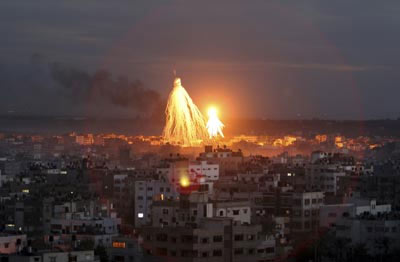by Ac.Krtashivananda
Four years ago on Nov. 4, while Americans were going to the polls to elect a new president, Israeli infantry, tanks and bulldozers entered the Gaza Strip to dismantle an extensive tunnel network used by Hamas to smuggle in weapons. An already tenuous truce mediated by the Egyptian government of Hosni Mubarak had been broken. Hamas responded with a barrage of mortar and rocket fire lasting several weeks, and on Dec. 27, 2008, Israel began Operation Cast Lead.
The military campaign began with seven days of heavy air strikes on Gaza, followed by a 15-day ground incursion. By the end of the campaign, nearly 1,000 poorly guided shorter-range rockets and mortar shells hit southern Israel, reaching as far as Beersheba and Yavne. Several senior Hamas commanders and hundreds of militants were killed in the fighting. Israel Defense Forces figures showed that 10 IDF soldiers died (four from friendly fire), three Israeli civilians died from Palestinian rocket fire and 1,166 Palestinians were killed – 709 of them combatants.
The strategic environment during the 2008-2009 Operation Cast Lead was vastly different from the one Israel faces in today’s Operation Pillar of Defence.
Operation Cast Lead
Hamas was operating in a difficult strategic environment during Operation Cast Lead. During Operation Cast Lead, Cairo did little to hide its true feelings toward Hamas. Though Egypt played a critical role in the cease-fire negotiations, it was prepared to incur the domestic political cost of cracking down on the Rafah border crossing to prevent refugees from flowing into Sinai and to prevent Hamas from replenishing its weapons supply.
The Egyptian Muslim Brotherhood, then in the opposition, took advantage of the situation to publicly rally against the Mubarak regime, but its protests did little to change the situation. Hamas was boxed in by Egypt and Israel.
The rest of the region largely avoided direct involvement.
Iran was the exception. While the Arab regimes ostracized Hamas, Iran worked to sustain the group in its fight. Tehran’s reasoning was clear and related to Iran’s emergence as a regional power. Iraq had already fallen into Iran’s sphere of influence (though the United States was not yet prepared to admit it) – Building up a stronger militant proxy network in the Palestinian territories was the logical next step in Tehran’s effort to keep a check on Israeli threats to strike the Iranian nuclear program.
The Current Geopolitical Environment
Hamas and Israel now find themselves in a greatly altered geopolitical climate. On every one of its borders, Israel faces a growing set of vulnerabilities that would have been hard to envision at the time of Operation Cast Lead.
The most important shift has taken place in Egypt, where the Muslim Brotherhood carefully used the momentum provided by the Arab Spring to shed its opposition status and take political control of the state. Hamas, which grew out of the Muslim Brotherhood, then faced an important decision. With an ideological ally in Cairo, Egypt no longer presents as high a hurdle to Hamas’ political ambitions. Indeed, Hamas could even try to use its ties to the Egyptian Muslim Brotherhood to achieve political legitimacy.
When unrest spread into Syria and began to threaten Iran’s position in the Levant, Hamas made a strategic decision to move away from the Iran-Syria axis, now on the decline, and to latch itself onto the new apparent regional trend: the rise of the Muslim Brotherhood and its Islamist affiliates across the Arab world.
This rise of the Muslim Brotherhood spread from Egypt to Syria to Jordan, presenting Israel with a new set of challenges on its borders.
A political machine such as the Muslim Brotherhood, which derives its power from the street, will be far more sensitive to pro-Palestinian sentiment than will a police state that can rule through intimidation.
The United States remains diplomatically involved in trying to reach a cease-fire, but as it has made clear throughout the Syrian crisis, Washington does not intend to get dragged into every conflagration in the Middle East. Instead, the United States is far more interested in having regional players like Egypt and Turkey manage the burden.
Saudi Arabia was already uncomfortable with backing more radical Palestinian strands, but Riyadh now faces a more critical threat — the regional rise of the Muslim Brotherhood. Islamist political activism poses a direct threat to the foundation of the monarchy, which has steadfastly kept the religious establishment out of the political domain. Saudi Arabia has little interest in the Egyptian Muslim Brotherhood encouraging Hamas’ political rise, and Riyadh will thus become even more alienated from the Palestinian theatre.
Hamas would not be able to strike Tel Aviv and Jerusalem with long-range rockets had it not been for Iran, which supplied these rockets through Sudan and trained Palestinian operatives on how to assemble them in Gaza.
Israel’s only hope to deny Hamas that victory is to eliminate Hamas’ arsenal of these rockets, all the while knowing that Iran will likely continue to rely on Egypt’s leniency on the border to smuggle more parts and weaponry into Gaza in the future. The Hamas rocket dilemma is just one example of the types of problems Israel will face in the coming years. The more vulnerable Israel becomes, the more prone it will be to pre-emptive action against its neighbours as it tries to pick the time and place of battle. In this complex strategic environment, Operation Pillar of Defence may be one of many similar military campaigns that Israel is struggling to adjust to this new geopolitical reality.
Noam Chomsky recently visited Gaza and reported his impressions in a moving piece ‘Even a single night in jail is enough to give a taste of what it means to be under the total control of some external force. And it hardly takes more than a day in Gaza to begin to appreciate what it must be like to try to survive in the world’s largest open-air prison, where a million and a half people, in the most densely populated area of the world, are constantly subject to random and often savage terror and arbitrary punishment, with no purpose other than to humiliate and degrade, and with the further goal of ensuring that Palestinian hopes for a decent future will be crushed and that the overwhelming global support for a diplomatic settlement that will grant these rights will be nullified’.
‘The intensity of this commitment on the part of the Israeli political leadership has been dramatically illustrated just in the past few days, as they warn that they will “go crazy” if Palestinian rights are given limited recognition at the UN. That is not a new departure. The threat to “go crazy” (“nishtagea”) is deeply rooted, back to the Labour governments of the 1950s, along with the related “Samson Complex”: we will bring down the Temple walls if crossed. It was an idle threat then; not today.’
The ongoing blitz on Gaza is surely another horrific example of Israel’s willingness to ‘go crazy’.
Source: Stratfor and Media Lens



